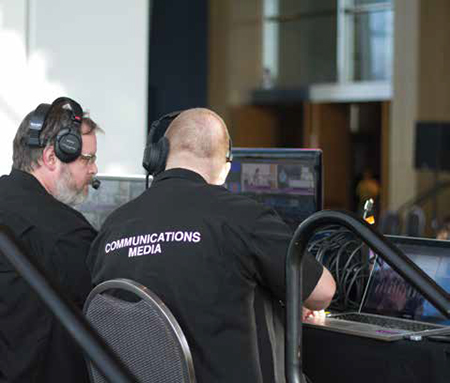Neal Fischer, ELCA South Carolina Synod using NewTek TriCaster Mini. Religious communities are coming together as never before, even when congregants are thousands of miles apart. As HOW customers become more aware of what technology can deliver, they’re taking full advantage of what’s available to spread the word.
“One of the biggest value propositions we see as being leveraged now is the ability to create automated video workflows,” said Phil Gauthier, account manager, Haivision. “HOW staffs and budgets are relatively tight, so anytime we can offer automation in their production workflows it’s a win-win. A big advantage for our clients is our Haivision Video Cloud, a cloud-based solution that helps HOW organizations to create ‘set and forget’ publishing workflows and provides them with a video management system. They can publish both live and on-demand video to websites, social media platforms (like YouTube and Facebook), as well as other media platforms (like iTunes, Roku, etc.). With the Haivision Video Cloud, churches can also broadcast their own TV channels online, scheduling specific content to play out as a ‘simulated live’ event or as a 24/7 channel.”
Megachurches, which typically have larger budgets, appreciate this system because of their need to manage large amounts of video content. But Gauthier noted that the technology’s market isn’t limited to the biggest spenders. “Smaller HOWs, with fewer members on media teams and less money also find it to be a time saver as they can easily schedule online content without spending too much time getting content online,” he said.
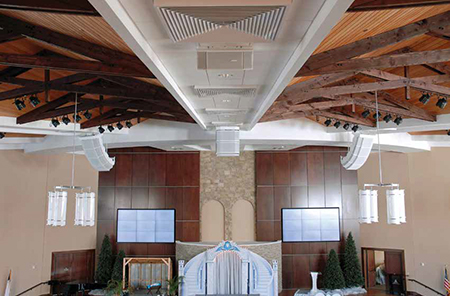
The Spring Meadows Seventh-day Adventist Church in Sanford, FL, offers community concerts, live broadcasts, and special events. The sanctuary pictured here features PA system components from Bose Professional. Most churches have a video and audio infrastructure in place for the worship room, explained Rob Read, marketing communications manager, Roland Professional A/V. “Adding streaming services is not much more money and is therefore affordable and scalable to fit most budgets. Churches are using streaming services to extend the reach of their ministries outside their local communities and to connect with members who are unable to attend in person.”
Multisite video streaming is quickly becoming the norm with HOWs, noted Mark D’Addio, vice president of business development and emerging markets, Vitec. “It allows churches, both big and small, to reach more people than ever before. It’s important because it enhances every churchgoer’s experience, no matter which campus he or she attends. Everyone at every site hears the same message, the one that’s being delivered at the main site.”
Many churches demand the highest quality of service, with immaculate video and audio, because the goal is to give the impression that the head pastor is actually presenting at each venue, he added. “High-quality streaming among multiple church sites has traditionally required high-priced broadcast equipment and expensive satellite transmission, but that is changing.”
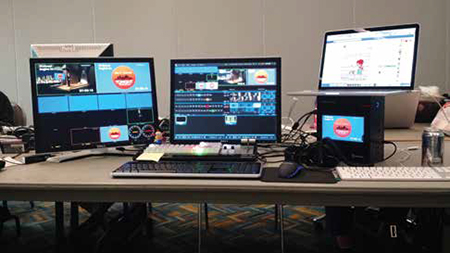
NewTek’s TriCaster Mini at the ELCA South Carolina Synod. One major difference in both the solution integration and the delivery is whether a church has multiple campuses. “That’s a distinction that, on the surface, can be seemingly divided along congregation size lines, but our smaller, more rural worship customers with lower populations are realizing economy-of-scale advantages too, often by joining forces with other small communities,” said Ellen Camloh, senior director, industry marketing, NewTek.
In addition to services, many churches want to create their own special programming, such as inspirational and educational programming for adult, youth, and children’s ministries, social media outreaches to connect with the next generation of members, fundraising, and other campaigns conducted in real-time,” she noted. “Our customers can make any of these possible with the same video production technology that they can use for producing the main worship service program.”
NewTek’s latest technology offering for worship customers has the ability to join a remote interview with an international missionary or guest speaker with the live worship production by way of Skype.
“A simple hardware device, NewTek TalkShow, installed with the rest of the video production equipment can take the Skype call and make visual and audio enhancements to it that give the in-house operator more control over the quality and technical elements that often are out of control using normal desktop software,” Camloh explained. “This can help bridge the distance, provide as consistent a quality as possible, and offer more unity of participation to remote attendees.”
Integrators face the task of integrating multiple video types, legacy SD equipment, and multiple video resolutions into one switcher, and sending out that signal using a single video resolution to the content delivery network said Rob Read, Roland Professional A/V. Pictured here is Fairfield Baptist Church, in the Atlanta suburb of Lithonia. Taking Up the Challenge
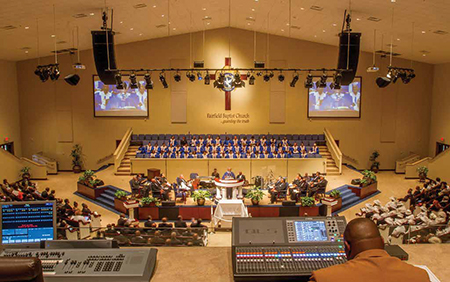
We see HOWs facing the need for adaptable, expandable technology that’s ready for their future needs, Camloh said. “For instance, our customers have found great value in purchasing integrated hardware rather than individual components so that future upgrades can be done in software, and in being able to support the older peripheral equipment in one site while updating the central production control in another site.”
Another challenge is in ensuring that with whatever solution they choose, the technology does not get in the way of the overall mission of the church, she added. “On the product-use side, that means user friendliness without a lot of operational obstacles to clear. Unobtrusive form factors are crucial to avoid having to deal with equipment, cabling, racks, or sprawling footprints that interfere with the service taking place.”
Integrators face the task of integrating multiple video types, legacy SD equipment, and multiple video resolutions into one switcher, and sending out that signal using a single video resolution to the content delivery network, Read noted. “Another challenge is in dealing with HDCP content in the video signal workflow. You may have permission to switch HDCP content at the church, but don’t have broadcasting rights, and switchers will disable SDI and USB outputs.”
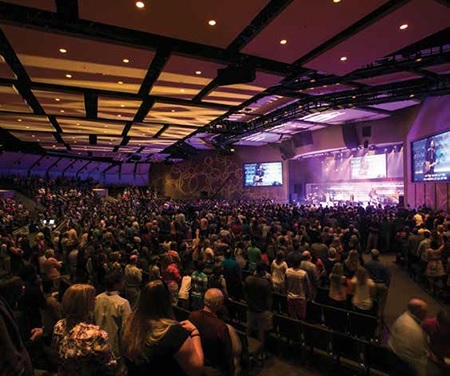
The Church of Highlands uses Haivision’s Connect DVR streaming solution to inspire nine remote campuses with simulated live video from the main campus based in Birmingham, AL. It’s not just about broadcast anymore, Gauthier cautioned. “Integrators have to understand that HOWs are leveraging new online technology tools because they want actual engagement (dialog) through social media or chat. It’s about building community around the message you’re sharing.”
The internet can provide a great medium for engaging interactions, he said. “One of our customers performed a baptism over Skype. The person being baptized was in Europe and the service was in Nashville. We also see clients with 24/7 streaming and rebroadcasting reaching people all over the world. The online model reaches all time zones and a global audience on virtually any screen, perfect for the emerging on demand consumer behavior.”
New technologies are also alleviating the impact that streaming video has historically put on IT departments and the LAN infrastructures, Gauthier said. “Thanks to innovations in video streaming—like our new video transport technology SRT which helps get high-quality video streams over bandwidth- constricted networks like the public internet—LAN and WAN infrastructures have become less of a factor when deploying video. That’s making it easier to broadcast and publish content, without putting a strain on the existing IT infrastructure of the church.”
Although not everyone has the budget for traditional satellite broadcast distribution, with advances in IP streaming technologies and IP infrastructure, even the smallest congregation with a modest budget can stream high-quality HD video between sites,” D’Addio concluded.
“HOWs, and many broadcasters for that matter, are still unaware of the high-quality service they can achieve with the latest IP solutions, which gives integrators an opportunity to educate them.”
Karen Mitchell is a freelance writer based in Boulder
Go Big or Go Small
No two HOW customers are the same. One may represent a small congregation exploring the possibilities of streaming and archiving, while another potential client may serve a megachurch.
“Even though video is becoming commonplace, and soon will be ubiquitous, the buying process is still nothing like buying a car, or a piece of office equipment,” said Ellen Camloh, senior director, industry marketing, NewTek. “Our customers in worship are not just checking boxes of features. They’re passionate about their missions and want to ensure they can achieve their communication and outreach goals right now and for the foreseeable future.”
Integrators must offer cost-effective streaming and archiving solutions that smaller HOWs can afford to help them match the reach of the megachurches, explained Mark D’Addio, vice president of business development and emerging markets, Vitec. “The latest IP technology includes H.264 and high efficiency video coding (HEVC), which Vitec offers with its MGW Ace, as well as IP error correction like Zixi and Pro-MPEG. Such technology and solutions ensure high-quality, reliable video and audio between and among sites.”
Selling streaming and archiving solutions to a mega-large HOW is pretty straightforward, noted Rob Read, marketing communications manager, Roland Professional A/V. “You explain that the broadcast/webcast production elements need to be separate and different from the in-house production. You design dedicated equipment for streaming and archiving of their worship service, and recommend a CDN (content delivery network) that can accommodate a wider range of concurrent viewers.”
Megachurches will probably require an HD workflow, whereas a smaller congregation might be happy with an SD stream and an integrated solution for both live production in the room and online. “Presenting different approaches, price points, workflows, and streaming services will make it attractive to each customer,” he said.
Smaller churches usually start off by publishing their content online to grow their audience, so they need solutions that can help them get their content online quickly. “Larger churches will tend to focus on extending their reach to other communities by adding remote campuses that need to be connected to the main location via live streaming,” Phil Gauthier, account manager, Haivision, said.
The beauty of what Haivision offers, he added, is in offering products that comprise various solutions for many industries as well as small and large organizations, including HOWs. “We bring solutions that allow them to select what their church might need, such as a small encoder and customized cloud service. We look at needs: for example, if they are publishing to iTunes or YouTube. We also offer a single point of video management, so customers can understand online engagement at all their online portals (social media sites, iTunes, etc.) based on a host of real-time analytics and viewer data.”
The cloud, Gauthier said, offers flexibility and can serve the HOW market really well. “Partnering with the Akamai content delivery network, we give our customers scalability. Churches can use a smaller amount of bandwidth as needed, and as they grow, the service scales with them.”
In both large-scale and small-scale cases, the challenge is to make live-streaming services seen by remote church members seem as intimate and relevant as the service conducted by the pastor in person, Camloh concluded.
“There is a balance in the technology that worship producers need to strike to avoid too much of a ‘produced’ look,” she said. “System integrators we work with are sensitive to selling a production system that seems too staged or theatrical, but they realize that low production quality is a distraction for those watching. Whatever the scale, when the pastor is speaking and the video is delivered in a clean, clear, crisp, and engaging picture that’s in total alignment with the message he’s getting across, the miles that separate satellite locations seem to disappear.”
